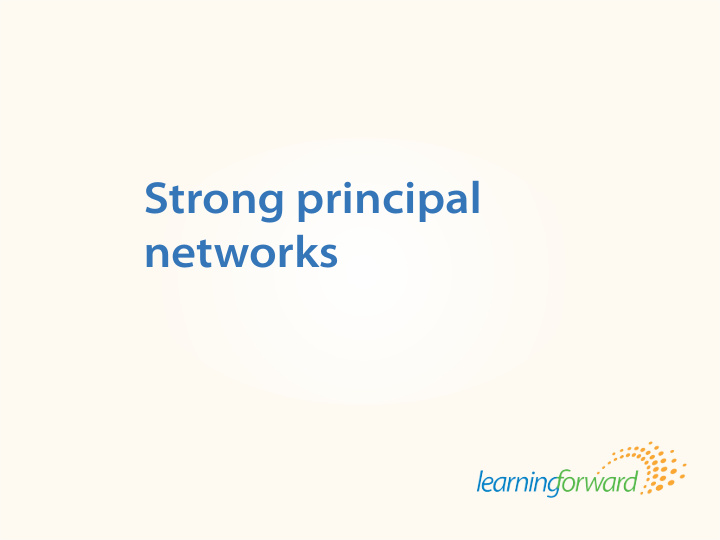



Title Body Strong principal networks Source
Download the original article and accompanying tools This presentation is a supplement to the full article. Download more information, resources, and tools to help you implement these ideas in The Learning Principal (Spring, This newsletter was 2013). made possible with support from Available at www.learningforward. org/publications/learning-principal.
The principal’s job is growing more complex • 75% of principals feel the job has become too complex. • 69% of principals say the job responsibilities are not very similar to fjve years ago. • 59% of principals are very satisfjed with their job, down from 68% very satisfjed in 2008. • 48% of principals feel under great stress. Source: MetLife. (2012). MetLife survey of the American teacher: Challenges for school leadership. NY: Author. Available at www.metlife.com/teachersurvey.
Job satisfaction increases within learning communities • Principals who are very satisfjed with their jobs are more likely to participate in a learning community with principals of other schools (93% vs. 79%). • Participating in a learning community is more common among principals who say they are not likely to leave the profession than among those who say they are likely to leave (89% vs. 82%). Source: MetLife. (2012). MetLife survey of the American teacher: Challenges for school leadership. NY: Author. Available at www.metlife.com/teachersurvey.
Principals need ongoing support Principals work largely in isolation, and experience with a supportive community of fellow principals is rare. Most principals receive training, are certifjed, and then become full-fmedged school leaders, without systems of ongoing learning or support. Source: Neale, E. & Cone, M. (2013, Spring) . Strong principal networks infmuence school culture. The Learning Principal 8(3). (p. 1).
Develop a network culture A strong network culture is critical to successful learning communities — specifjcally, a culture based on trust, collaborative learning, and collective responsibility. Source: Neale, E. & Cone, M. (2013, Spring) . Strong principal networks infmuence school culture. The Learning Principal 8(3). (p. 4).
Build trust • Principals learn about themselves as leaders and implement new efgorts at school when they believe the network is a safe space. • Attributes of a safe group: skilled facilitator, established group norms, and models of risk- taking by long-time group members. • Facilitators should emphasize sharing, listening, learning, and increasing leadership capacity and student achievement. Source: Neale, E. & Cone, M. (2013, Spring) . Strong principal networks infmuence school culture. The Learning Principal 8(3). (pp. 1-3).
Engage in collaborative learning Harness the knowledge and capacity that individual principals bring with them and build upon their existing strengths. Discuss national leadership research, explore school-based problems, examine possible solutions, and share experiences with implementation. Source: Neale, E. & Cone, M. (2013, Spring) . Strong principal networks infmuence school culture. The Learning Principal 8(3). (pp. 1-3).
Develop collective responsibility • Maintain a sense of mutual accountability for all members. • Hold each other responsible for applying what they learn. • Implement learning communities within members’ own school settings. • Visit each other’s campuses and share resources to develop a sense of collective ownership within the learning community. Source: Neale, E. & Cone, M. (2013, Spring) . Strong principal networks infmuence school culture. The Learning Principal 8(3). (pp. 1-3).
Learn more with Learn more about professional learning at all levels of education with Learning Forward , an international nonprofjt association of learning educators: www.learningforward.org Membership in Learning Forward gives you access to a wide range of publications, tools, and opportunities to advance professional learning for student success.
Recommend
More recommend